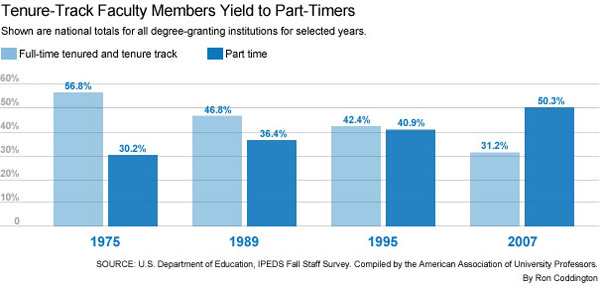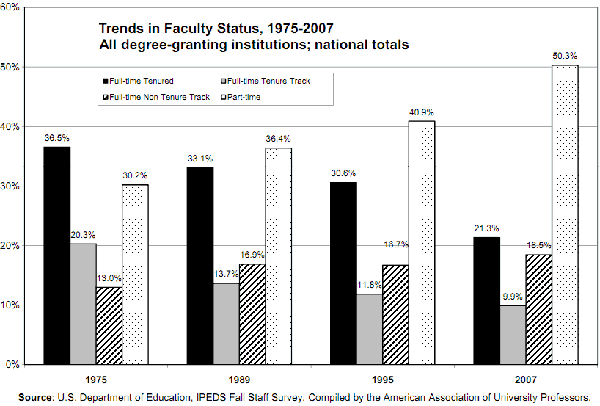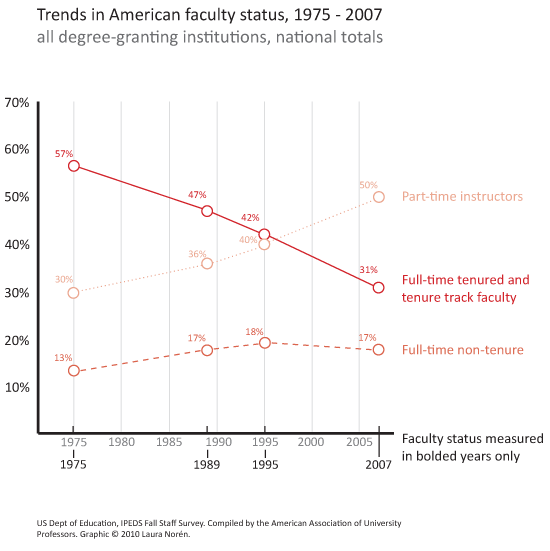
Tenure dies, three graphics
Tenure is declining. There are many reasons for this, most of which are economic. Tenured professors are very expensive compared to, say, adjuncts and graduate student TAs. Once upon a time in departments far far away, even recitation/discussion sessions were led by tenured faculty members. The only experience I ever had with such a situation was in a department (physics) heavily funded by dollars from the Department of Defense. Don’t say the militaristic state never gave you anything, my fellow classmates. I’m not bragging, but I do think I am pretty clever when it comes to Newtonian physics, at least for a sociologist.
The story here is clear in the graphics…or is it?
This first graphic ran in The Chronicle of Higher Education last July in an article written by Robin Wilson who asked:
“What does vanishing tenure mean for higher education? For starters, some observers say that college faculties are being filled with people who may be less willing to speak their minds: contingent instructors, usually working on short-term contracts….But others argue that the disappearance of tenure is actually not the worst thing that could happen in academe. The competition to secure a tenure-track job and then earn tenure has become so fierce in some disciplines that academe may actually be turning away highly qualified people who don’t want the hassle. A system without tenure, but one that still gave professors reasonable pay and job security, might draw that talent back.”
It’s not my place to get into that discussion here, but I do want to interrogate the graphic that ran with the story to see if it captured the essence of the tenure story.
First, the Chronicle’s graphic has numbers that do not add to 100%. So I went back to the report from the American Association of University Professors that the Chronicle had pulled their numbers from and came up with this:

This report clearly has more detail – we can see where those missing numbers are (full-time non-tenured faculty) – as well as understand the distinction between full-time already tenured faculty and those who are in the process of seeking full-time tenured positions.
I decided to compile this information into a line graph for two reasons. First, a line graph is the best way to show trends over time. Second, the data were collected at odd intervals so the eye would not have an easy time just stringing together a line connecting the bar graphs to understand the pattern. I imposed a grid. I added in the missing category. I gave it some color (darker colors correspond to more reliable, financially sound employment categories; lighter colors refer to more fleeting or otherwise less remunerative employment categories).

References
(16 December 2010) The disposable academic: Why doing a phd is often a waste of time The Economist. Accessed online but it ran in the print edition.
Relevant quote:
“The earnings premium for a PhD is 26%. But the premium for a master’s degree, which can be accomplished in as little as one year, is almost as high, at 23%. In some subjects the premium for a PhD vanishes entirely. PhDs in maths and computing, social sciences and languages earn no more than those with master’s degrees. The premium for a PhD is actually smaller than for a master’s degree in engineering and technology, architecture and education.”
Wilson, Robin. (4 July 2010) Tenure, RIP. In The Chronicle of Higher Education.
The Annual Report on the Status of the Profession, 2007. The American Association of University Professors. Fact Sheet: 2007.

Comments 3
PS Birch — December 30, 2010
I am curious as to whether this is one of those situations where absolute numbers would be preferable to percentages.
While the percentage figure does provide explicit data that the blend has changed such that there are more non-faculty professors than faculty professors*, it does not necessarily follow that "tenure is declining." It is possible that the number of tenured professors has merely not increased at as significant a rate as non-tenured professors.
I dug through a couple of the original reports from the dept of Gov and found the following data points for Staff at 4 year Colleges and universities. It's not conclusive as it's only indicative of changes over a 3 year period, but still interesting:
2007: (http://nces.ed.gov/pubs2009/2009154.pdf Table 2)
With tenure 236,303 (21.2%)
On tenure track 104,217 (9.4%)
Not on tenure track 125,305 (11.3%)
No tenure system 34,689 (3.1%)
Without faculty status 611,741 (55%)
2009: (http://nces.ed.gov/pubs2011/2011150.pdf Table 3)
With tenure 244,358 (20.7%)
On tenure track 104,994 (8.9%)
Not on tenure track 131,354 (11.1%)
No tenure system 38,562 (3.3%)
Without faculty status 660,885 (56%)
Comparing just those tenured, the percentage change from 2007 to 2009 of 21.2% to 20.7% might appear to lend weight to the argument that "tenure is in decline," however the absolute numbers of 236,303 and 244,358 shows there are some 8,000 more tenured professors in 2009 than there were three years prior.
This trend carried through on all Faculty categories. The increase in staff without faculty status, that shows why; Institutions increased their faculty by 18,754 positions, compared to adding 48,144 non-faculty teaching positions.
So yes -- the data does show that individuals teaching at colleges and universities are more likely to be non-faculty now than three years ago, but 8,000 of those ~68,000 hired in the last 3 years did achieve tenured positions. I wouldn't be surprised if this trend continued back into the 70s. As such, the title of the Chronicle article might rather be "Non-Tenured Positions Increasing"
* Note : It is entirely possible that I chased down the wrong reports and the particular data points are not the same as those in your graph. Even in this instance however I believe the underlying premise -- that absolute numbers rather than / in addition to the percentages would be useful to give a better understanding of the data being represented.
T — January 8, 2011
Agree with PS. While the percentages are shifting towards a larger 'contingent' instructional staff... but is this just a function of full-time hiring not keeping up with the Academy's pace of growth.
Around the web 1/12 | Left Eye On Books — January 12, 2011
[...] Tenure is dying (thesocietypages.org) [...]